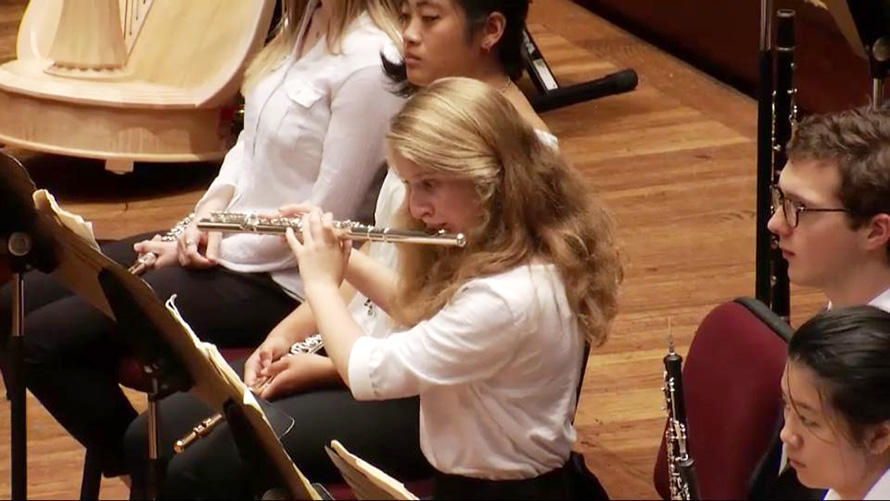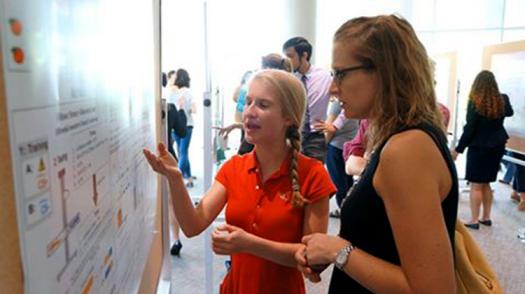Alumni, ISEF, Science Talent Search
Neuroscience and music are more related than you think

Sometimes, science and art converge in beautiful ways. Sara Kornfeld Simpson embodies that incredible meshing. She is double majoring in neuroscience and music at Boston University and has played the flute for 11 years and the oboe for 9.
“There’s absolutely a connection between science and art, on many levels!” said the Intel ISEF 2011-2012 finalist and Intel STS 2014 semifinalist. “Both my scientific and artistic endeavors stimulate and excite my intellect, require discipline, problem-solving, and creativity, and are critical to my identity.”
On September 17, Sara will perform at the Society’s Signature Alumni Event in New York. The event will feature two presentations with alumni leaders from business, social entrepreneurship, and digital marketing sectors.
Read on below to learn more about Sara’s scientific and artistic journey.
THE CONNECTION BETWEEN SCIENCE AND ART: There’s absolutely a connection between science and art, on many levels! First, there are some really interesting studies about music and the brain. For example, cognitive neuroscientists are trying to understand how we perceive rhythm, tonal structure, and a sense of key in music, and how our perception of musical structure (arguably, “syntax”) compares to the way our brain processes language.
There are some really interesting studies about music and the brain.
But music does more than provide a topic for intellectual investigation, it also provides scientists with an artistic outlet. I know many scientists who are also musicians that perform in local orchestras and find music to be a joyful way to pass time outside of the lab. Personally, I have found studying music seriously to not be too different from performing scientific research — tireless hours of benchwork and optimizing techniques leading up to a critical experiment is not too different from tireless hours in a practice room leading up to a big performance. Both my scientific and artistic endeavors stimulate and excite my intellect, require discipline, problem-solving, and creativity, and are critical to my identity!
Both my scientific and artistic endeavors stimulate and excite my intellect, require discipline, problem-solving, and creativity, and are critical to my identity!
HER CURRENT STEM GOALS: I hope to pursue doctoral studies in neuroscience and spend the rest of my life doing neuroscience research at an academic or private research institution. Currently, I am very interested in research about the mechanisms by which the brain modulates neural signals and the way these neuromodulatory mechanisms facilitate behaviors like learning and remembering stimuli. My current research at Boston University relates to this topic, and I hope to do further research on it in graduate school.
Society alumni are champions of science. You can become a champion of science too.

HOW SHE BECAME INTERESTED IN STEM: I became interested in neuroscience as a result of a music performance. While in middle school, I performed a recital at the former Neurosciences Institute in La Jolla, California. After the performance, I learned a little bit about the kind of research that was done there and was fascinated. Later on, as part of a job-shadowing event, I was in the audience listening to two neuroscientists discuss their research on music and the brain. Though my interests are now more aligned with neurobiological research rather than the cognitive methods used to study music and the brain, I have never lost interest in this fascinating topic that sparked my curiosity about the mind.
Intel ISEF launched me into the STEM world and ignited my excitement about scientific research!
THE IMPORTANCE OF SCIENCE FAIRS: Intel ISEF launched me into the STEM world and ignited my excitement about scientific research! Science fairs allowed me to pursue my interest in neuroscience and to conduct high-level scientific research — far beyond the school curriculum — at a young age.
Most important to my developing passion for science, each science fair — from the local level through Intel ISEF — gave me the opportunity to discuss my research with professional scientists. They listened to my poster presentation carefully and attentively, asked challenging questions, and encouraged me to continue my research, which inspired me to take myself and my work seriously and feel like a part of the broader scientific community.
I recently attended a science fair at Boston University where high school students presented their summer research to students and faculty. It was my first time being the listener and the students’ joy in answering my questions and discussing their research reminded me so clearly of the value of this special interaction provided uniquely by science fairs. I hope to continue to be a part of science fairs for the rest of my life; I think this is an invaluable way to excite young minds about STEM.
Science fairs … inspired me to take myself and my work seriously.
HER ADVICE TO YOUNG PEOPLE INTERESTED IN STEM: I cannot emphasize enough the importance of curiosity. I believe there are no “bad” questions, and science moves forward because of inquisitiveness and curiosity. Never be afraid to wonder and dream, or to voice your queries and thoughts!


